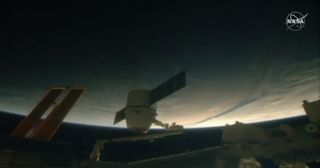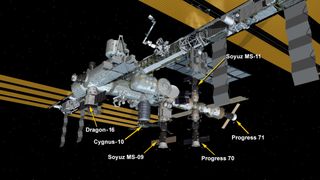SpaceX Dragon Delivers Cargo (and Christmas Treats) to Space Station
A SpaceX Dragon cargo ship made a special delivery at the International Space Station Saturday (Dec. 8) just in time for the holidays. And yes, Virginia, there are Christmas treats on board.
The robotic Dragon spacecraft arrived at the space station Saturday morning to deliver more than 5,600 pounds (2,540 kilograms) of fresh supplies for the six Expedition 57 astronauts on the orbiting lab. SpaceX launched the Dragon ship Wednesday (Dec. 5) from the Cape Canaveral Air Force Station in Florida on Wednesday (Dec. 5).
Station commander Alexander Gerst of the European Space Agency captured the Dragon capsule with a robotic arm at 7:21 a.m. EST (1221 GMT) as both spacecraft sailed 249 miles above the Pacific Ocean, just north of Papua New Guinea. Gerst and his crew are likely looking forward to the supplies packed aboard the spacecraft.
"On this resupply craft they also have some special things like candied yams, green bean casserole and even some Christmas cookies," NASA spokesperson Leah Cheshier said during live commentary.

The spacecraft is also carrying a trove of science gear for 250 experiments, including a robotic in-space refueling demonstration, a powerful GEDI laser to study Earth's forests and a novel SlingShot device designed to launch up to 18 cubesats from a Cygnus cargo ship already at the station. A team of space-traveling mice and 36,000 worms are also on making the space trip.
Dragon's arrival was delayed briefly due to a communications glitch between a NASA's Tracking and Data Relay Satellites (TDRS) and a ground station in White Sands, New Mexico. A processor at the ground station for the TDRS East satellite failed, forcing NASA to switch to a different TDRS satellite to restore communications with the space station.

Dragon was forced to back away to a safe station-keeping position 100 feet (30 meters) from the station, then make a new approach about an hour later than planned. Flight controllers at NASA's Mission Control center in Houston then took remote control of the station's arm to attach Dragon to its berth on the orbiting lab's Harmony module.
Get the Space.com Newsletter
Breaking space news, the latest updates on rocket launches, skywatching events and more!
Today's space rendezvous marks the 16th cargo delivery mission for NASA by SpaceX. The Dragon on this flight, called CRS-16, has actually visited the space station before. It delivered supplies to the station February 2017 as part of NASA's CRS-10 mission.
Dragon will be the sixth spacecraft to link up with the space station in recent months. Its arrival follows a Russian Soyuz crew capsule, which arrived last week with three new crewmembers, and the Northrop Grumman Cygnus cargo ship in November. Another Soyuz crew capsule and two uncrewed Russian Progress cargo ships are also docked at the station.
"We congratulate the entire ISS team for managing six individual spaceships that will be simultaneously docked to the International Space Station from today on," Gerst said. "This shows what a successful science and exploration program we have up here, making full use of the one and only microgravity observatory that humanity has available for the benefit of all humans on Earth."
SpaceX's Dragon capsule will spend about four weeks at the space station before returning to Earth, according to company representatives. In January, the spacecraft will be filled with about 4,000 pounds (1,814 kg) of experiment results and other gear and released back into space. It will splash down in the Pacific Ocean to be retrieved by a SpaceX recovery ship.
Email Tariq Malik at tmalik@space.com or follow him @tariqjmalik. Follow us @Spacedotcom and Facebook. Originally published on Space.com.
Join our Space Forums to keep talking space on the latest missions, night sky and more! And if you have a news tip, correction or comment, let us know at: community@space.com.

Tariq is the Editor-in-Chief of Space.com and joined the team in 2001, first as an intern and staff writer, and later as an editor. He covers human spaceflight, exploration and space science, as well as skywatching and entertainment. He became Space.com's Managing Editor in 2009 and Editor-in-Chief in 2019. Before joining Space.com, Tariq was a staff reporter for The Los Angeles Times covering education and city beats in La Habra, Fullerton and Huntington Beach. In October 2022, Tariq received the Harry Kolcum Award for excellence in space reporting from the National Space Club Florida Committee. He is also an Eagle Scout (yes, he has the Space Exploration merit badge) and went to Space Camp four times as a kid and a fifth time as an adult. He has journalism degrees from the University of Southern California and New York University. You can find Tariq at Space.com and as the co-host to the This Week In Space podcast with space historian Rod Pyle on the TWiT network. To see his latest project, you can follow Tariq on Twitter @tariqjmalik.
